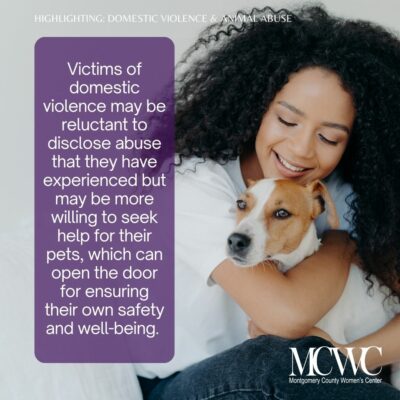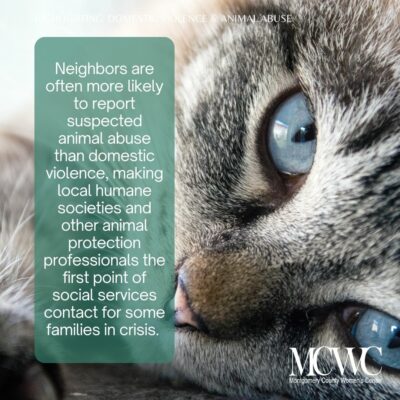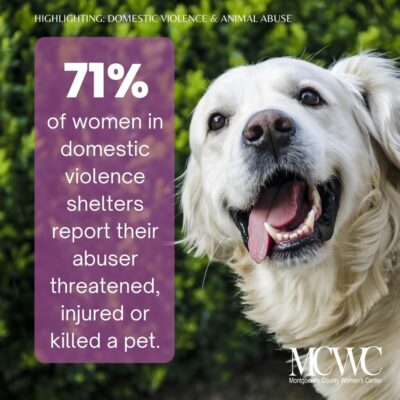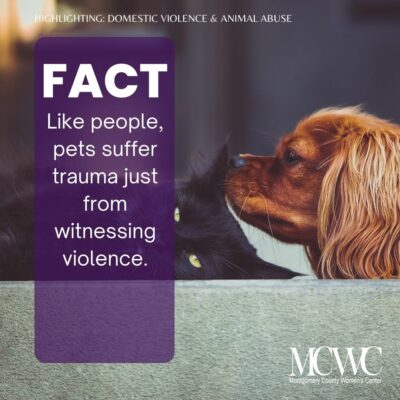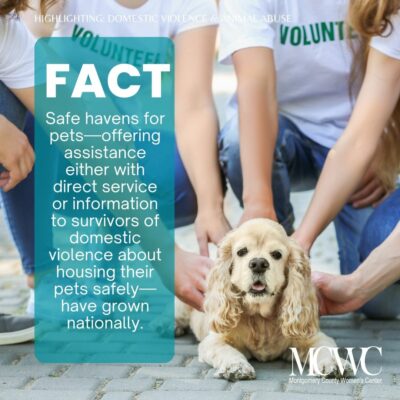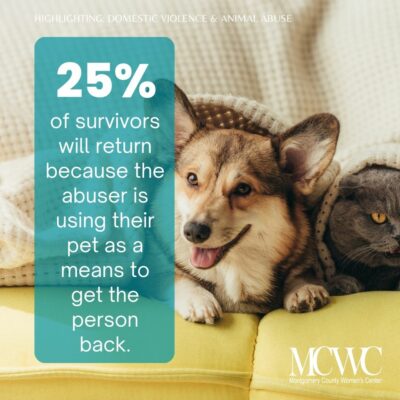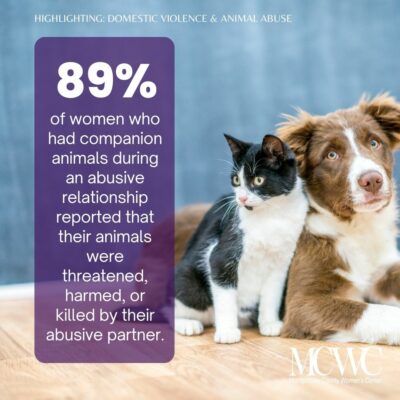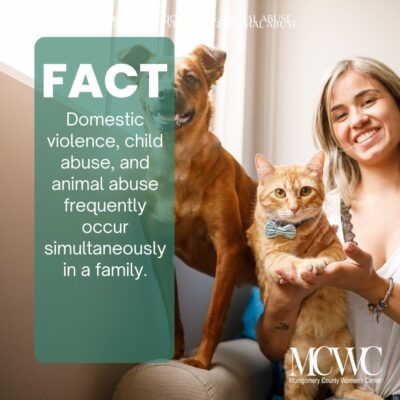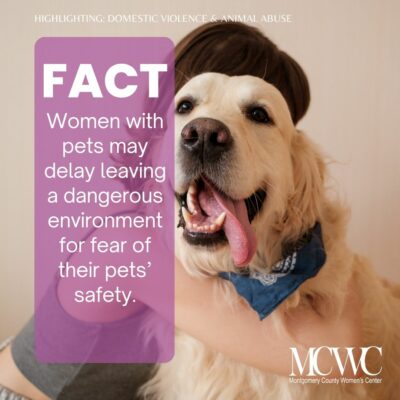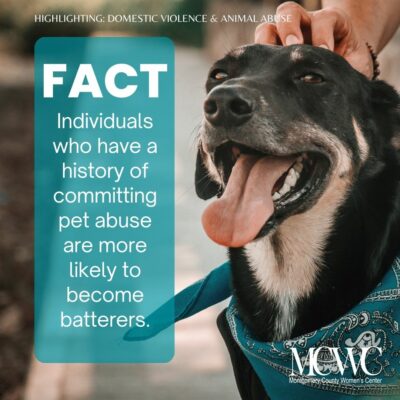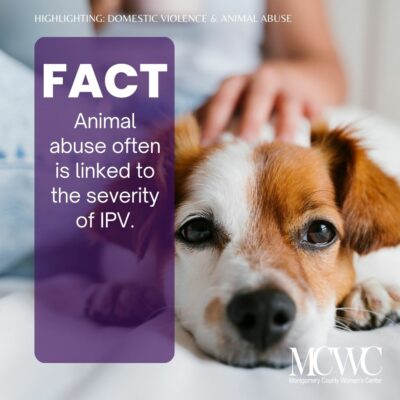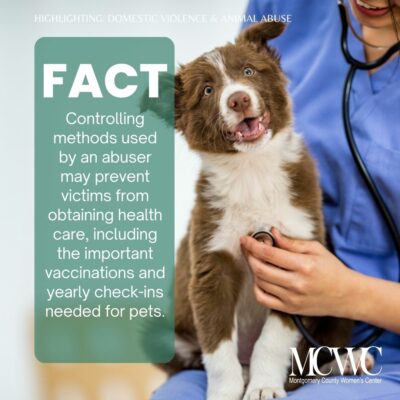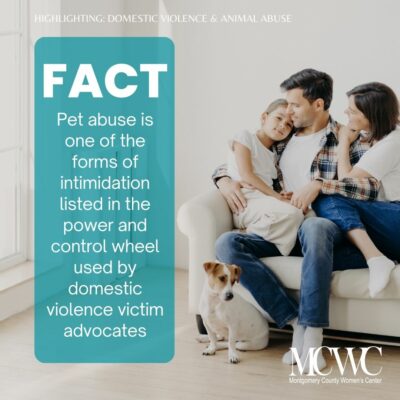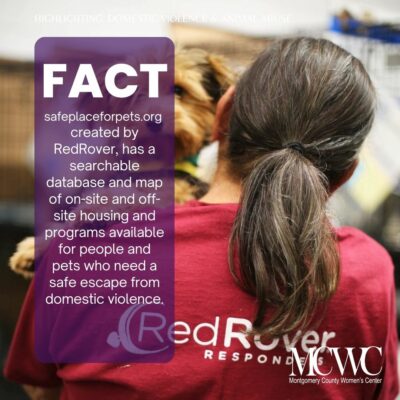Research shows abusers often have a pattern of violence towards all members of the household – including children and pets. When domestic violence survivors seek to flee their abusers, many are faced with the challenge of finding shelter for themselves, their children, and their pets. Many shelters do not have the means to house companion animals. Sadly, many survivors stay in abusive homes for fear that the abuse of their animals will escalate if they’re left behind, or that threats to their animals will be used to compel them to go back.
An abusive home isn’t just dangerous to people. Pets suffer too. They can become targets or pawns in a cruel game. Abuse directed toward the pet is often used as a representation or warning of what the perpetrator may do to the human victim. Abusive people threaten a pet in order to prevent family members from leaving or from disclosing violence to others. Pets depend on their people and community to care for them and to provide safe haven. One population of denizens in our community who are too often overlooked when it comes to being affected by domestic violence is pets of victims. A pet that is exposed to domestic violence can have troubling behavioral issues that last a lifetime and can, if not addressed, create difficulties in their care. Their long-term health trajectory, just like a victim’s, can be negatively impacted by their experiences within the home.
When a pet is in peril, making the decision to leave an abusive situation gets more complicated. Nearly half of domestic violence survivors surveyed said they had delayed leaving or returned to an abusive situation out of fear for their animals’ welfare, said Gupta. As many as eight out of 10 women entering domestic violence shelters say their abuser threatened, harmed, or killed a family pet. Today in the U.S., more than 30 states have policies to safeguard both humans and pets from violence in the home. More than 250 domestic violence shelters are pet-friendly. When you’re ready to leave an abusive situation, where can you find pet-friendly assistance?
https://redrover.org/relief-dv/safe-place-for-pets/
https://houstonspca.org/animal-cruelty-rescue-services/petsafe/
Pets are part of American families – a poll conducted in 2015 found that 95% of pet owners consider their pets to be family members. What is more, pets often serve as the only source of unconditional love for individuals living in abusive relationships. In fact, abusers often manipulate their victims via their bonds with pets. Consider the following scenario: a victim of abuse attempts to flee, but the abuser threatens the life or well-being of a cherished pet to coerce the victim into remaining in the dangerous relationship. In similarly troubling scenarios, abusers use threats to pets to prevent children from reporting physical and sexual abuse.
Research shows abusers often have a pattern of violence towards all members of the household – including children and pets. When domestic violence survivors seek to flee their abusers, many are faced with the challenge of finding shelter for themselves, their children, and their pets. Many shelters do not have the means to house companion animals. Sadly, many survivors stay in abusive homes for fear that the abuse of their animals will escalate if they’re left behind, or that threats to their animals will be used to compel them to go back.
A correlation between animal abuse, family violence and other forms of community violence has long been established. Philosophers and educators have been describing the connections between animal abuse and interpersonal violence since the 14th century. Child and animal protection professionals have recognized the association, noting that abuse of both children and animals is connected in a self-perpetuating cycle of violence. When animals in a home are abused or neglected, it is a warning sign that others in the household may not be safe. In addition, children who witness animal abuse are at a greater risk of becoming abusers themselves.
People who hurt animals don’t stop with animals. There is an established link between cruelty to animals and violence toward humans — regularly referred to as “The Link.”. Ample research backs up the finding that there is a direct link between acts of cruelty to animals and violence toward humans. This includes child abuse, domestic violence, elder abuse and other violent behavior. This link makes it critically important that cruelty toward animals be taken seriously by law enforcement, and by society at large. This is for the sake of the animals themselves, and for people who are also at risk.
- A landmark 1997 study by the Massachusetts Society for the Prevention of Cruelty to Animals and Northeastern University found that animal abusers are in fact five times as likely to also harm other humans.
- A 1983 study notes that animal abuse was found in 88% of homes in which physical child abuse was being investigated.
- A 2017 study showed that 89% of women who had companion animals during an abusive relationship reported that their animals were threatened, harmed, or killed by their abusive partner.
Controlling methods used by an abuser may prevent victims from obtaining health care, including the important vaccinations and yearly check-ins needed for pets. Many victims are subjected to financial abuse, which makes it difficult for them to pay for necessary pro-active health measures for a pet, as well as any emergency care needs. This is often a purposeful objective of the abuser.
According to the 2013-2014 National Pet Owners Survey, 68% of U.S. households, or 82.5 million homes, include a companion animal. In most cases, these companion animals are cherished members of the family. However, up to 70% of domestic violence victims report having a pet, and when a batterer causes violence in the home, it can be inflicted on pets as well (Ascione, 1997; Loring & Bolden-Hines, 2004).
Experts estimate that between 60- 71% of battered women have pets that also have been abused or killed (Ascione, et al, 2007). Moreover, pet abuse is one of the forms of intimidation listed in the power and control wheel used by domestic violence victim advocates. Abusers threaten, injure, and at times kill pets in order to control their victims and to create an environment of fear within the home. The close relationship that battered women and their children feel toward their companion animals complicates their willingness to leave a violent situation, potentially putting their pets at risk of violence or death.
From various studies we know that approximately 20 -48% of women have refused to leave a dangerous situation for fear of their pets’ safety (Carlisle-Frank, Frank & Nielsen, 2004; Ascione, 2007). Some survivors have reported living in their cars with their pets rather than leaving them behind. Staff at domestic violence shelters has also found that children may experience additional trauma when separated from beloved pets (Flynn, 2000).
The human-animal bond can facilitate healing, aid attachment, and provide a source of comfort to survivors and their children (Sprinkle, 2008). We can see the significance of pets in our lives very early on. When asked to identify the 10 most important individuals in their lives, 7- and 10- year old children in one study included two pets on their lists. In another study, 42% of 5-yearolds spontaneously mentioned their pets when asked, “Whom do you turn to when you are feeling sad, angry, happy, or wanting to share a secret?” (Foer, 2006).
The human-animal bond can facilitate healing, aid attachment, and provide a source of comfort to survivors and their children (Sprinkle, 2008). We can see the significance of pets in our lives very early on. When asked to identify the 10 most important individuals in their lives, 7- and 10- year old children in one study included two pets on their lists. In another study, 42% of 5-yearolds spontaneously mentioned their pets when asked, “Whom do you turn to when you are feeling sad, angry, happy, or wanting to share a secret?” (Foer, 2006).
There are now “Court House Dogs” (http://www.safehumanechicago.org/), many of whom have been rescued themselves and who now assist children and adult witnesses involved in the court system so that their stress is reduced and they can feel more comfortable. Often animal assisted therapy utilizes dogs, but many other species also are involved (e.g., horses, birds, and goats).
Today in the U.S., more than 30 states have policies to safeguard both humans and pets from violence in the home. More than 250 domestic violence shelters are pet-friendly. When you’re ready to leave an abusive situation, where can you find pet-friendly assistance? safeplaceforpets.org, created by RedRover, a US non-profit, has a searchable database and map of on-site and off-site housing and programs available for people and pets who need a safe escape from domestic violence.
Many times, clients are conflicted about coming into shelter because they are worried about the safety and care of their pets. MONTGOMERY COUNTY WOMEN’S CENTER recognizes the importance of providing a loving and safe atmosphere for our clients’ pets. Since we do not want this to be a barrier to escape for any victim/survivor, we have partnered with the following organization:
PET PROTECT: PET BOARDING FOR DOMESTIC VIOLENCE SURVIVORS
If you are a survivor of domestic violence and are in need of a place to safely board your pet(s) while you are in transition, we are here to help you. In order to ensure we best serve you and your pet, please complete the following steps:
In order for your pet to be enrolled in the Pet Protect program, you must be referred to us by a sheltering agency or a law enforcement agency
- Contact a local shelter to reserve your space, please see the list of shelters below
- Once you’ve secured a spot, request the pet intake form from your shelter
- Your sheltering agency will help you make contact with our pet boarding partners
- Houston PetSet will cover the cost of your pet’s boarding for up to 60 days
VISIT FOR MORE INFORMATION: https://www.houstonpetset.org/pet-protect/
“It wasn’t just the cats and the dogs I had, it was the sheep and the chickens – I was terrified for their welfare. I knew if I were to leave, he wouldn’t hesitate to kill them. He had done it before.”, said Susan Walsh as she discussed her experiences. Susan’s husband had retaliated against her and her children, preventing her from leaving an abusive relationship by threatening to harm her pets and farm animals. This story is not an isolated incident. It’s a widespread epidemic with 71% of battered women reporting that their abusers had harmed, killed, or threatened animals as a way to control them. A growing body of research establishes the link between domestic violence and animal abuse. Animal cruelty is often an indicator of interpersonal violence such as child abuse, intimate partner violence, and elder abuse. Pet abuse is one of the four predictors of domestic partner violence with 85% of women and 63% of children who enter shelters in the United States reporting incidents of pet abuse.
The complexities of domestic violence run like an undercurrent in our community. As witnesses, we are all affected by the negative impact of these complexities. Thanks to our amazing community of partners who recognize these nuances we can connect victims with an array of supports that not only address the crisis, but help to extend services of basic needs that ultimately help to break the cycle of domestic violence.


